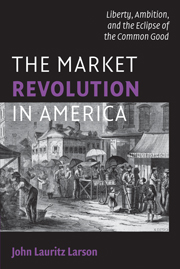Book contents
- Frontmatter
- Contents
- Acknowledgments
- Introduction: What Do We Mean by a Market Revolution in America?
- 1 First Fruits of Independence
- Interlude: Panic! 1819
- 2 Marvelous Improvements Everywhere
- Interlude: Panic! 1837
- 3 Heartless Markets, Heartless Men
- 4 How Can We Explain It?
- Epilogue: Panic! 2008, Déjà vu All over Again
- An Essay on the Sources
- Index
Interlude: Panic! 1819
Published online by Cambridge University Press: 05 June 2012
- Frontmatter
- Contents
- Acknowledgments
- Introduction: What Do We Mean by a Market Revolution in America?
- 1 First Fruits of Independence
- Interlude: Panic! 1819
- 2 Marvelous Improvements Everywhere
- Interlude: Panic! 1837
- 3 Heartless Markets, Heartless Men
- 4 How Can We Explain It?
- Epilogue: Panic! 2008, Déjà vu All over Again
- An Essay on the Sources
- Index
Summary
“Let every Shylock leave his hole, and in the open day boldly sharpen his knife, to take ‘the pound of flesh’ nearest the heart of his honest neighbor!” So wrote Baltimore journalist Hezekiah Niles about news from the Bank of the United States, in August 1818, that free exchange of notes among various regional branches would be suspended. Ranting wildly in graphic prose, Niles condemned the “Rag Barons” and their “paper system” for the “criminal” abuse of honest persons and taxpayers. Whatever suspicions he had harbored since 1816 about the wisdom of chartering a new national bank stood vindicated now that the crooks and swindlers in charge of this engine of currency manipulation had turned their “knives” upon the people, not just “skinning as heretofore” but cutting deep at the “arteries of the public body” to get “blood enough at once to swim in.” So began the national nightmare known to history as the Panic of 1819.
Part and parcel of the postwar economic boom had been a dramatic expansion of the American money supply. As exports recovered from the wartime disruption, productivity expanded, and the promise of rapid growth returned, state and local banks, especially in the West and South, multiplied their loans and note issues with little regard for specie reserves or underlying values. All banks had stopped converting paper money into coin during the late war, so there was no effective check on this proliferation of banknotes.
- Type
- Chapter
- Information
- The Market Revolution in AmericaLiberty, Ambition, and the Eclipse of the Common Good, pp. 39 - 45Publisher: Cambridge University PressPrint publication year: 2009



